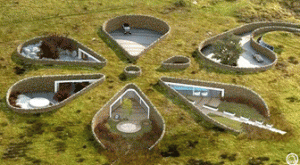D237Leaf Carving: New Art Form
It’s hard not to love the brilliant display of colourful foliage that signals the entrance of autumn each year, but as the cold winter winds prevail, those leaves that once beautified the landscape are left to collect on the ground or be begrudging raked-up in some weekend chore. A new art form emerging out of China, however, is making use of these brittle leaves – creating delicate forms that will continue to be appreciated long after the jackets and sweaters of winter are hung in closets and the green buds of a new season sprout.
Creating these leaf carvings is no easy process, taking the delicate precision from a skilled artisan. With a knife, the leaf is slowly scraped of its outer layers, eventually revealing a near transparent surface. Special care is given to keep the veins intact to preserve the stability of the leaf.
Artists prefer using the leaves of the Chinar tree, native to India, Pakistan, and China. Resembling maple leaves, the distribution of veins in the Chinar leaves are the best suited for sculpting and they are considered ‘lucky’ in Chinese tradition.
The process of producing a single leaf carving is said to take months of careful work. When the artwork is finished, the leaves are then preserved and framed- ensuring that they will last for decades.
Several web sites are available to order carved leaves online, like at Hanan Xingyi.
Such art is impressive not only for its beauty, but also for creating it from such a sustainable resource. Each autumn, trees around the world shed their colorful leaves – but who knew that all along they could be the perfect canvas for an artists with a creative mind and a steady hand?
Shared by TreeHugger, an online media outlet dedicated to driving sustainability mainstream
Glowing Wallpaper Could Be a Better Way to Light Your Home
Thin is in, especially regarding digital displays like television and laptop screens. Now new graphene-based electrode technology has been developed which promises to provide affordable glowing displays which can be applied as wallpaper or applied to ceilings to provide a green, energy saving alternative to light bulbs, according to Sciencedaily.com
Today’s ultra-thin lighting technology is mostly based on organic light diodes called OLEDs, which are widely used commercially in everything from mobile phones to televisions. Although OLEDs are fairly energy efficient, they have two major drawbacks: they are relatively expensive to produce, and they consist of the metal alloy indium tin oxide which is rare and complicated to recycle.
These concerns are part of what led Swedish researchers from Linköping and Umeå universities, in coalition with American colleagues, to develop a new alternative to the flat screen. Based on organic light-emitting electrochemical cells (or LECs), the transparent electrode is made of the carbon material graphene.
“By using graphene instead of conventional metal electrodes, components of the future will be much easier to recycle and thereby environmentally attractive,” said one of the scientists, Nathaniel Robinson from Linköping University.
And since LEC parts can be produced from liquid solutions, they can be produced as large, flexible sheets from a printing press. Such a manufacturing process would be cost-effective, and it would pave the way for inventive methods of using the materials, as with developing glowing wallpaper.
Although glowing wallpaper based on OLED technology has been envisioned and developed before, its excessive cost and the rarity of idium tin oxide made it an unlikely and impractical alternative for home lighting. With LEC technology, however, those obstacles are gone.
Once made commercially viable, glowing wallpaper could provide better widespread lumination across a room than traditional lightbulbs, be more energy efficient, easier to recycle, and create a super-cool, Tron-like atmosphere. Furthermore, the raw material for the fully organic and metal-free LEC is inexhaustible and can even be recycled as fuel.
The technology could also make it possible to frequently change wallpaper patterns and designs, or even take a room’s occupant from a virtual tropical beach setting to the top of Mount. Everest with the click of a switch.
A New Traffic Sign: “Take Turns”
The inventor Gary Lauder unveiled this new idea at the TED conference: A traffic sign that instructs drivers to “take turns” at an intersection. The TED blog explains:
Half a stop and half a yield, the sign gives each driver a clear indication of how to behave. Below the red “Take Turns” shield is a small sign reading, “If Cars Are Waiting, Please Stop and Alternate.” And if there are no cars waiting, just blow on through.
The ice cream cone shape isn’t quite as simple as an octagon. And if you were unfamiliar with this sign you might wonder how to “TAKE TURNS.” A sign that just says “STOP” is pretty unambiguous.
But that said, once people got the hang of the “TAKE TURNS” sign, it would work well. If you see someone waiting at the intersection you’re approaching, you stop and let them go first. The only problem case that I can think of would be two people approaching the intersection at the same time from perpendicular streets and both trying to “blow on through.” And as a general point, why don’t we have more innovation when it comes to traffic signs and signals? Is there a consensus we’re working with the optimal set?
Shared by TreeHugger, an online media outlet dedicated to driving sustainability mainstream
The Zero-carbon Underground Eco Home
This new, flower-shaped 8,000 square foot house, which is being built for soccer star Gary Neville by Make Architects, is promising to be zero-carbon. Here’s how they say they’re going to fulfill that promise: It’s underground, which will keep it cool in summer, a ground-source heat pump will provide heat, and energy comes from solar panels and an on-site wind turbine. Lots of skylights obviate the need for electricity during the day, and buil-ding materials will be local and sustainable. Also awesome is that “whenever possible,” they will use traditional building methods.
World’s Largest Tree House Stands 10-Stories Tall
16 years ago, Horrace Burges had a divine vision, a calling from heaven. And, like the ark-crafting Noah before him, Horrace picked up a hammer and built a large wooden structure of his own – the world’s largest tree house. At 10 stories tall, with roughly 10,000 square feet, the tree house may be more aptly called a ‘tree mansion’, but according Horrace, it’s a work in progress.
Located in Crossville, Tennessee, Horrace built the tree house was using only recycled lumber, donated or salvaged from demolition sites. He says that since so much of the material used to build the house was given to him, the whole project has only cost him around $12 thousand – most of which was spent on nails.
The structure, which climbs 100 feet into the air, is mainly supported by a single large tree which makes up it’s foundation-though a spiral staircase allows access inside from the ground level. The ‘tree mansion’ has become quite the tourist attraction in Crossville since Horrace opened it up to the public – with nearly 400 visitors a week coming to take a look at what he’s built.
Shared by GOOD, a collaboration of individuals, businesses, and nonprofits pushing the world forward









Wonderful blog!